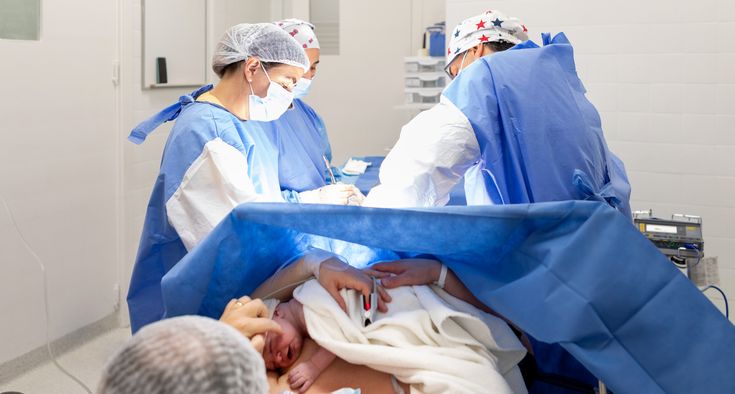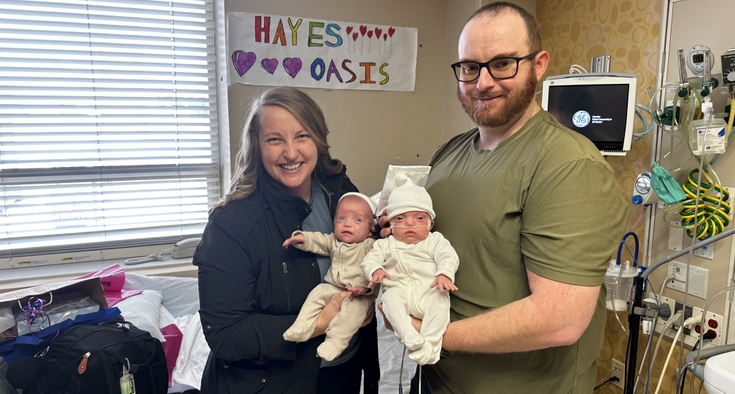When you picture giving birth, chances are you imagine a vaginal delivery. For many people, that’s how it goes. But sometimes, labor takes a different turn, and a cesarean section (C-section) becomes the safest path forward.
The discourse around pregnancy and birth often pits “natural” delivery against medical intervention, framing a C-section as something to fear or avoid. But the truth is more nuanced.
“Childbirth is natural,” said Novant Health OB-GYN Dr. Rachel Jones. “But medical intervention continues to make it safer.”
Jones explained how Novant Health’s maternity care teams always encourage vaginal delivery when safe and appropriate, but sometimes, it’s just not possible.
Whether or not a C-section was part of your original birth plan, knowing what to expect in case of a C-section can help you feel more prepared, confident, and more in control of your birthing experience.
Expert care for every stage of pregnancy.
Can you explain what a C-section is?

A C-section is the surgical delivery of the infant. It's done by making about a 10-centimeter (3.9-inch) incision on the lower abdomen, right below the bikini line. This is about as long as a popsicle stick. We carefully dissect through the layers of the abdominal wall and into the uterus to surgically deliver the infant. Then we repair all those layers as we move out of the abdomen.
Some lesser-known things about C-sections are that we still try to do delayed cord clamping, which is routine with vaginal delivery. Delayed cord clamping is the practice of waiting 30 to 60 seconds post-delivery to clamp and cut the umbilical cord. This allows the infant to get up to 80% of the blood from the umbilical cord right after birth.
The placenta also has to be removed, and we take it out through the uterine incision. Lastly, we don’t cut the abdominal muscles — what you might typically think of as your “six-pack” muscles. We separate them temporarily.
Contrary to what you might think, it’s not more common for women with C-sections to experience diastasis recti, or a separation of the abdominal muscles.
What is anesthesia like during a C-section?
Most women undergo what’s called regional anesthesia. This will either be an epidural, if they were in labor before the C-section, or a spinal injection. Regional anesthesia allows women to be awake for the procedure. The medications used do not circulate to the b
In an extreme emergency, there may not be sufficient time to do regional anesthesia. There are also some medical conditions where people cannot have regional anesthesia. For example, some women who have had certain types of back surgery or have certain bleeding disorders may not be candidates. In those cases, we would opt for general anesthesia.
A common misconception about anesthesia is that there will be no feeling at all. I always try to warn patients ahead of time that there is usually some pressure, so they won’t be nervous when they feel that. Before we start the C-section, we do a test to make sure that they don't sense pain before we get started.
If someone feels something unpleasant, the most common thing is nausea, and that's usually related to the spinal anesthesia. You can inform your nurse anesthetist or anesthesiologist immediately, and they can help correct the issue.
How is the experience of giving birth via C-section different from giving birth vaginally?
It’s more of a passive procedure for the mom in that she is lying there as things happen. In a vaginal delivery, she's going to need to be pushing and be more of an active participant in the delivery.
Even if they aren't actively pushing, we are speaking to them throughout the procedure. They can see the baby as soon as she or he is born. We try to get skin-to-skin contact happening as soon as possible. So we really try to have those women still feel involved, even though they aren't having to push and do the same work associated with a vaginal delivery.
Are you willing to accommodate a request for a C-section?
Yes, we are. Current American College of Obstetrics and Gynecology (ACOG) guidelines state that a woman who wants a C-section with no medical reason is entitled to have one at or after 39 weeks after counseling on her other options. ACOG is the body whose recommendations for care for expectant mothers and women in general we follow most closely.
If a woman comes to us and wants a C-section for no other reason than preference, we try to give her the medical information she needs to make the best decision. If, after that discussion, she decides that she wants a C-section, then we will do that.
From our standpoint, when it is safe for mom and for baby, we definitely prefer vaginal delivery, but we respect a woman's ability to make a decision after appropriate counseling.
What are the risks and benefits of a C-section versus a vaginal delivery?
For a C-section, the most significant benefit is a much lower risk of injury to your pelvic floor and loss of bladder and bowel control that can follow vaginal delivery.
On the other hand, the two most significant benefits of an uncomplicated vaginal delivery are going to be an easier recovery for the mother and avoidance of surgical risk. The baby also has a slightly higher chance of transitioning to breathing outside the womb better.
When it comes to risks, there are surgical risks with a C-section. These include risk of bleeding, infection and/or injury to internal organs.
Thankfully, these are very uncommon things, and we are always prepared for anything that might happen. We also administer antibiotics as a precaution.
For vaginal deliveries, the biggest risks in uncomplicated deliveries are tearing of the perineum (the area between the vagina and the rectum) or even tearing into the rectum. The latter is extremely uncommon, but both are very uncomfortable for the mom.
When would an emergency C-section be necessary?
The most common reasons we perform emergency C-sections are:
- Babies whose heart rate goes down during labor and doesn’t come back up.
- Severe bleeding that's immediately life-threatening to the mom or baby.
- A cord prolapse. This occurs when the umbilical cord falls out of the vagina while the baby's still up in the uterus.
In which cases is a planned C-section necessary?
The most common reason is that the mother has had a prior C-section. Other reasons might be a baby who’s breech, meaning the bottom is sitting in the mother’s pelvis rather than the head. Either the parents opted against trying to turn the baby, or that was attempted and not successful. The placenta could be implanted in an area that makes a C-section the only option. Planned C-sections are also commonly performed for patients carrying twins or triplets.
For any reason, parents will be given an arrival time at the hospital and will also have a pre-operative visit in the office before the procedure, where we will walk them through the entire process.
Do you always try to turn breech babies, and if so, how?
We try to turn breech babies at our practice as long as a woman desires for this to be done and is an appropriate candidate, which most are. The procedure is performed in the hospital. The mom comes in to the labor and delivery unit. We physically try to push the bottom up out of the pelvis, and then we try to roll the baby either forward or backward. If it doesn't work in one direction, we try it in the other direction.
Throughout the procedure, we intermittently check with an ultrasound to make sure the baby's heart rate is doing well and check the position of the baby. It's a vigorous procedure. It is not always successful, but when the baby is able to be turned, it’s fantastic.
How can the mother retain a sense of empowerment throughout a C-section?
We give mothers a sense of agency by honoring all reasonable, safe preferences. Women choose the type of music played in the operating room to set the tone. We have a clear drape that can be used for the delivery if they would like, so that they can see the baby right away.
The surgeon has to do the initial cutting of the cord because it is a sterile procedure, but their partner, or whoever they choose, can do the final cord cut. They can also decide if they would like someone to narrate the procedure to them or not, be it a provider or a support person.
What can a patient do to prepare for a planned C-section, physically, mentally and emotionally?
With any sort of delivery, whether it's a C-section or vaginal delivery, stay as fit as possible — it helps you recover better from surgery. It also helps you if you need to push for delivery. Having a balanced, nutritious diet helps with the healing involved both before and after delivery. Get as much sleep as possible.
Pregnant women generally cannot sleep well at the end of pregnancy, but just do the best you can. And one of the biggest things to prepare for the recovery, particularly with the movement limitations after a C-section, is to know who will help you while you recover.
What does the role of the support partner become before, during and after a C-section?
The support person is super important during a C-section, because it can be a little scary for a patient having a cesarean section to just be in the operating room and not be able to see everything that's going on. The support person helps them stay calm as a familiar presence.
What does the day look like for a patient, from arrival to post-op, when undergoing a planned C-section?
The day technically starts the night before. The patient will be asked to stop eating and drinking at a specific time set by the anesthesia team. We ask them to arrive at least two hours before their scheduled time to be there, get an IV placed, get some lab work done, and have their admission process completed by the nursing staff.
Then, they are walked back to the operating room. Unfortunately, the schedule doesn't always run on time, because labor and delivery is a very dynamic environment. We always let our patients know ahead of time that labor and delivery is unpredictable.
The procedure itself is usually less than an hour from start to finish. It's not a long surgery. Most women are in the recovery room for one to two hours, and then they'll go to a mother-baby unit, where most stay two nights.
When will mom first get to hold the baby?
We try not to let the C-section change the ability to do skin-to-skin bonding for mom and baby. Babies are briefly taken to the warmer to ensure that all the fluid is out of their lungs. As soon as we're sure that they're breathing well, then they go up to mom's chest, just like they would in a vaginal delivery, and they can stay with the mom up until the end of the procedure.
What does C-section recovery look like, and how is it different from recovery post-vaginal delivery?
24-48 hours afterward
They’ll have a Foley catheter (a tube that allows urine to drain from the bladder) placed during a C-section, after anesthesia is administered. That usually stays in for up to one day after the C-section, and it doesn’t limit a mother’s ability to get up out of bed. We encourage women to get up out of bed and walk early to help with recovery.
However, mothers who are undergoing a C-section should expect to need assistance to move. It’s going to be more challenging to get into bed, to get out of bed, and to change positions. They’ll also have IV fluids running for at least a few hours after the C-section, but they can eat everyday foods.
Up to 4 weeks post C-section
Compared to an uncomplicated vaginal delivery, there's more pain at first. We treat that pain actively to help patients not suffer during that time. The healing takes four weeks, although patients do tend to feel a lot better by about a week after surgery. There are some restrictions that people have after C-sections that they don't have with a vaginal delivery.
For example, they can't lift more than 10 pounds for four weeks, which can be challenging to balance if there is another young child at home. They also can't drive for two weeks, and routine wound care is required.
When it comes to wound care, the incision itself will often be located under a fold of skin, as the abdominal wall doesn’t immediately flatten post-birth. It’s critical to remember to keep the wound clean and dry. Lift any skin covering the incision and wash with warm, soapy water.
What does pain management look like after a C-section?
A recovering woman’s pain management regimen may look like scheduled Tylenol and ibuprofen combined with an abdominal binder, heat and ice packs. Stronger pain medication is also available if needed.
We give all women who have had a C-section an abdominal binder (a wide compression belt) to use at home. We suggest using either that or some sort of support garment, as well as continuing to use heat and ice at home.
These are considered comfort measures, compared with pain medications. They aren’t going to work well for everybody, but if you can find what works best for you in addition to your pain medications, that’s what matters.
When can mothers expect to be mobile again?
We advise against vigorous exercise until at least the four- to six-week postpartum follow-up visit. Gentle strolling is appropriate as the mom starts to become mobile again, but until you can check in with your health care team, it’s too much of a risk to try to get back into your exercise routine.
Is it true that women are refusing C-sections against the advice of their obstetrician?
Yes, we have seen a trend in that direction. It can be difficult when we’re making a decision in the best interest of the mother and baby, and the patient declines it. We do try to engage patients in decision-making as much as possible. While childbirth is a natural process, medical care makes it safer. Prior to today's medical technology and advancements, mothers and babies died much more frequently during childbirth.
I think it’s important to underline that we can maintain patient autonomy within the guardrails of medical care — it doesn’t have to be one or the other. If there is a point when mom or baby becomes at risk of harm or death due to declining medical treatment, that becomes a really difficult situation.
An example would be a baby not tolerating labor because of oxygen deprivation. That could cause brain injury for the baby. If someone refuses a C-section in that situation, they could increase that risk for their baby.
I believe the broader cultural shift toward increased patient autonomy is influencing this, but I also think there is a significant amount of misunderstanding and misinformation circulating.
It is not correct that we want to do C-sections or want to do interventions. We’re very much for vaginal delivery; we don’t want women doing elective C-sections. (You can read more here about what Novant Health is doing to help reduce the number of C-sections.)
What do you want every woman to know about a C-section?
I think the most important thing to know is that it does not in any way diminish the mom and baby’s ability to bond, to have early connections, to do skin-to-skin contact, or to nurse. At the end of the day, we always want to do what’s safest for mom and baby, and we also want a happy, healthy delivery. In that way, our goals are aligned with the patient’s.
Additionally, if you have questions or concerns, ask them and voice them. Keep an open dialogue with your health care team. We’re always here to help. Part of every obstetrician’s job is to try to make sure people are prepared for all possibilities. You can also look for mom groups in your area and explore the maternity classes and events at a Novant Health location near you so you can start building a support network of people in the same phase of life.










